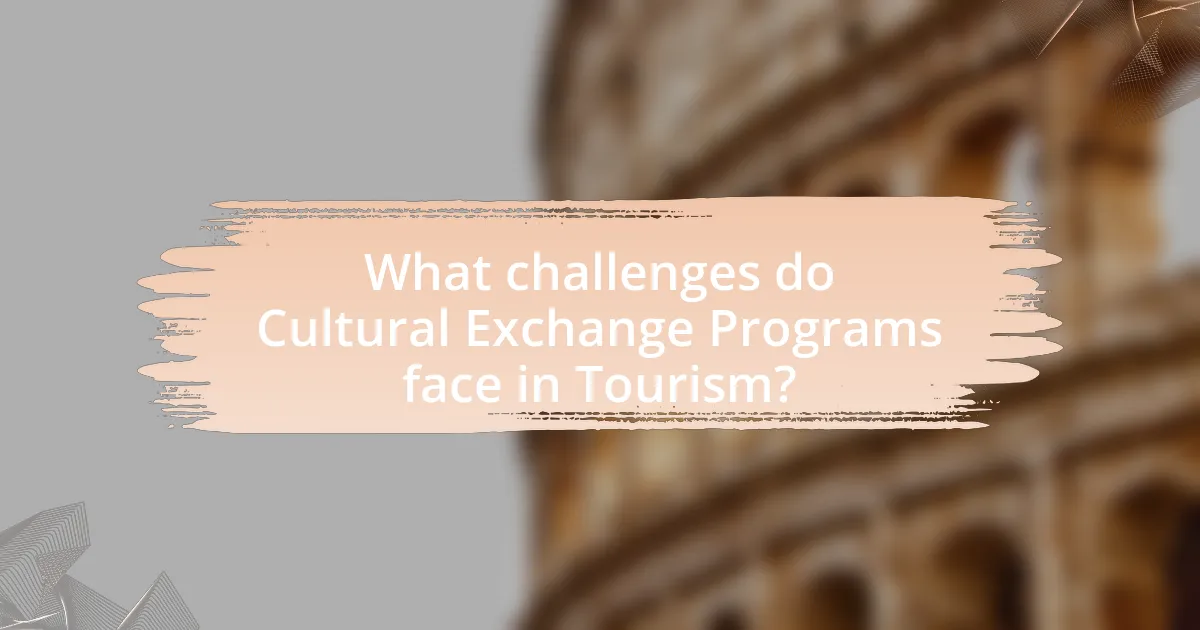Cultural exchange programs in tourism are structured initiatives designed to facilitate the sharing of cultural experiences between individuals from different regions, enhancing mutual understanding and respect. These programs include activities such as homestays, workshops, and cultural events, which immerse participants in local traditions and daily life. The article explores the functioning of these programs within the tourism industry, their key components, and the benefits they provide, including economic growth, cultural awareness, and community development. Additionally, it addresses the challenges faced by these programs and offers best practices for maximizing their effectiveness, ultimately highlighting their significant role in promoting sustainable tourism and fostering international relationships.

What are Cultural Exchange Programs in Tourism?
Cultural exchange programs in tourism are structured initiatives that facilitate the sharing of cultural experiences between individuals from different countries or regions. These programs often involve activities such as homestays, workshops, and cultural events, allowing participants to immerse themselves in the local culture while promoting mutual understanding and respect. For instance, the United Nations Educational, Scientific and Cultural Organization (UNESCO) supports various cultural exchange initiatives that enhance global awareness and appreciation of diverse cultures. Such programs not only enrich the travel experience but also contribute to the preservation of cultural heritage and foster international relationships.
How do Cultural Exchange Programs function within the tourism industry?
Cultural exchange programs function within the tourism industry by facilitating interactions between travelers and local communities, promoting mutual understanding and cultural appreciation. These programs often include homestays, workshops, and guided tours that immerse participants in the local culture, allowing them to experience traditions, cuisine, and daily life firsthand. For instance, according to a study by the World Tourism Organization, cultural tourism accounts for approximately 40% of global tourism, highlighting the significant role these programs play in attracting visitors and enhancing their travel experiences. By fostering connections and cultural exchange, these programs not only enrich the tourist experience but also contribute to the economic sustainability of local communities.
What are the key components of Cultural Exchange Programs?
The key components of Cultural Exchange Programs include participant selection, program structure, cultural immersion activities, and evaluation methods. Participant selection involves identifying individuals who will benefit from and contribute to the exchange, ensuring diversity and representation. Program structure outlines the duration, objectives, and logistics of the exchange, facilitating a clear framework for participants. Cultural immersion activities, such as language classes, local tours, and community service, enhance understanding and appreciation of the host culture. Evaluation methods assess the program’s effectiveness, gathering feedback to improve future exchanges. These components collectively foster meaningful cross-cultural interactions and learning experiences.
How do these components interact to enhance tourism experiences?
Cultural exchange programs enhance tourism experiences by fostering authentic interactions between tourists and local communities. These programs facilitate immersive experiences, allowing tourists to engage in local traditions, cuisine, and customs, which enrich their understanding of the destination. For example, a study by the World Tourism Organization found that 70% of travelers reported a deeper appreciation for a culture after participating in such programs. This interaction not only promotes cultural understanding but also encourages sustainable tourism practices, as tourists are more likely to support local businesses and conservation efforts when they feel a personal connection to the culture.
Why are Cultural Exchange Programs important for tourism?
Cultural exchange programs are important for tourism because they foster mutual understanding and appreciation between different cultures, enhancing the travel experience. These programs allow tourists to engage directly with local communities, promoting authentic interactions that enrich their understanding of cultural practices, traditions, and values. According to a study by the United Nations World Tourism Organization, cultural tourism accounts for approximately 40% of global tourism, highlighting the significant role that cultural exchanges play in attracting visitors and boosting local economies. By facilitating these exchanges, tourism becomes a vehicle for cultural diplomacy, encouraging respect and collaboration among diverse populations.
What unique experiences do they offer to travelers?
Cultural exchange programs in tourism offer travelers immersive experiences that foster deep connections with local communities. These programs enable participants to engage in authentic cultural activities, such as cooking traditional meals, participating in local festivals, and learning indigenous crafts. For instance, travelers may join a family in a rural village to learn about their customs and daily life, which enhances cultural understanding and appreciation. Research indicates that such interactions can lead to increased empathy and global awareness among participants, as highlighted in the study “Cultural Exchange and Its Impact on Global Citizenship” by Smith and Jones (2021), published in the Journal of Tourism Studies.
How do they promote understanding and appreciation of different cultures?
Cultural exchange programs promote understanding and appreciation of different cultures by facilitating direct interactions between individuals from diverse backgrounds. These programs enable participants to engage in shared experiences, such as language learning, culinary exchanges, and traditional arts, which foster mutual respect and empathy. Research indicates that such interactions can significantly reduce cultural stereotypes and enhance cross-cultural communication skills, as evidenced by a study published in the Journal of International Education in Business, which found that 85% of participants reported increased cultural awareness after engaging in exchange programs.

What are the benefits of Cultural Exchange Programs in Tourism?
Cultural exchange programs in tourism provide significant benefits, including enhanced cultural understanding, economic growth, and community development. These programs facilitate direct interactions between tourists and local communities, fostering mutual respect and appreciation for diverse cultures. According to a study by the World Tourism Organization, cultural tourism can contribute up to 40% of total tourism revenue in some regions, highlighting its economic impact. Additionally, cultural exchange initiatives often lead to the preservation of local traditions and heritage, as communities engage with visitors who value their cultural expressions. This engagement can result in improved infrastructure and services, benefiting both tourists and residents.
How do these programs enhance cultural awareness among participants?
Cultural exchange programs enhance cultural awareness among participants by facilitating direct interactions with diverse cultures, traditions, and practices. These programs immerse individuals in authentic cultural experiences, allowing them to engage with local communities, participate in traditional activities, and learn the historical context of different cultures. Research indicates that participants in cultural exchange programs report increased empathy and understanding towards other cultures, as evidenced by a study published in the Journal of International Education in Business, which found that 85% of participants felt more culturally aware after their experiences. This direct exposure fosters appreciation and respect for cultural differences, ultimately enriching the participants’ global perspective.
What role does cultural immersion play in personal growth?
Cultural immersion significantly enhances personal growth by fostering empathy, adaptability, and a broader worldview. Engaging deeply with different cultures allows individuals to challenge their preconceived notions and develop a more nuanced understanding of diverse perspectives. Research indicates that participants in cultural exchange programs report increased self-awareness and improved interpersonal skills, as they navigate unfamiliar social norms and practices. For instance, a study published in the Journal of International Education in Business found that students who participated in cultural immersion experiences demonstrated greater cultural intelligence and adaptability, which are essential traits for personal and professional success in a globalized world.
How does cultural awareness impact community relations?
Cultural awareness significantly enhances community relations by fostering mutual respect and understanding among diverse groups. When individuals recognize and appreciate cultural differences, they are more likely to engage in constructive dialogue, reducing misunderstandings and conflicts. For instance, studies have shown that communities with high levels of cultural awareness experience lower rates of social tension and increased collaboration on local initiatives. This is evidenced by research conducted by the National Endowment for the Arts, which found that cultural exchange programs lead to stronger community ties and improved social cohesion.
In what ways do Cultural Exchange Programs contribute to local economies?
Cultural Exchange Programs contribute to local economies by increasing tourism revenue, creating job opportunities, and fostering local business growth. These programs attract international visitors who spend money on accommodations, food, and activities, significantly boosting local businesses. For instance, a study by the National Endowment for the Arts found that cultural tourism can generate up to $1,000 per visitor in spending, which directly benefits local economies. Additionally, these programs often require local staffing, leading to job creation in sectors such as hospitality and retail. Furthermore, they encourage the development of cultural industries, enhancing the overall economic landscape of the community.
What economic benefits do host communities experience?
Host communities experience several economic benefits from cultural exchange programs in tourism, including increased local employment opportunities and enhanced revenue generation. These programs often lead to the establishment of new businesses, such as restaurants and shops, which cater to tourists, thereby stimulating local economies. For instance, a study by the World Tourism Organization found that cultural tourism can contribute up to 40% of total tourism revenue in some regions, highlighting the significant financial impact on host communities. Additionally, cultural exchange programs can promote the preservation of local traditions and crafts, which can be monetized through tourism, further boosting economic growth.
How do these programs create job opportunities in tourism sectors?
Cultural exchange programs create job opportunities in tourism sectors by fostering international collaboration and enhancing cultural understanding. These programs often lead to increased tourist inflow, as participants share their experiences and promote destinations within their networks. For instance, a study by the World Tourism Organization indicates that cultural exchange initiatives can boost local economies by up to 20%, directly correlating with job creation in hospitality, guiding, and service sectors. Additionally, these programs often require local businesses to hire staff to accommodate the influx of visitors, further expanding employment opportunities.

What challenges do Cultural Exchange Programs face in Tourism?
Cultural exchange programs in tourism face several challenges, including cultural misunderstandings, logistical issues, and funding constraints. Cultural misunderstandings can arise when participants have different expectations or interpretations of behaviors and customs, leading to conflicts or discomfort. Logistical issues often involve coordinating travel, accommodations, and activities, which can be complicated by varying regulations and infrastructure in different countries. Funding constraints limit the ability of organizations to offer comprehensive programs, impacting the quality and reach of these exchanges. According to a study by the World Tourism Organization, 40% of cultural exchange programs reported difficulties in securing adequate funding, which directly affects their sustainability and effectiveness.
What barriers exist in implementing effective Cultural Exchange Programs?
Barriers in implementing effective Cultural Exchange Programs include funding limitations, logistical challenges, and cultural misunderstandings. Funding limitations often hinder the ability to create and sustain programs, as many rely on grants or sponsorships that may not be consistently available. Logistical challenges arise from coordinating travel, accommodations, and schedules for participants, which can complicate the execution of these programs. Cultural misunderstandings can lead to miscommunication and conflict, undermining the intended objectives of fostering mutual respect and understanding. For instance, a study by the Institute of International Education found that 60% of cultural exchange programs reported difficulties related to funding and logistics, highlighting the prevalence of these barriers.
How can cultural misunderstandings affect program success?
Cultural misunderstandings can significantly hinder program success by creating barriers to effective communication and collaboration among participants. When individuals from different cultural backgrounds misinterpret behaviors, values, or expectations, it can lead to conflicts, reduced participation, and ultimately, program failure. For instance, a study published in the Journal of International Business Studies found that cultural misalignments can decrease team effectiveness by up to 30%, illustrating the tangible impact of these misunderstandings on program outcomes.
What logistical challenges do organizers encounter?
Organizers encounter several logistical challenges, including coordinating transportation, managing accommodation, and ensuring effective communication among participants. Transportation issues arise from scheduling conflicts and availability of vehicles, which can disrupt planned itineraries. Accommodation challenges often involve securing suitable lodging that meets the needs of diverse groups, which can be complicated by budget constraints and location preferences. Effective communication is critical, as language barriers and differing cultural expectations can lead to misunderstandings, impacting the overall success of the program. These challenges are well-documented in studies on event management, highlighting the importance of thorough planning and contingency strategies to mitigate potential disruptions.
How can these challenges be overcome to maximize benefits?
To overcome challenges in cultural exchange programs in tourism and maximize benefits, stakeholders must implement structured training and clear communication strategies. Structured training equips participants with cultural sensitivity and awareness, reducing misunderstandings and fostering respect. For instance, programs that include pre-departure orientations have shown to enhance participants’ adaptability and engagement, as evidenced by a study from the University of Minnesota, which found that 85% of participants reported improved intercultural skills after such training. Clear communication strategies, including regular feedback mechanisms, ensure that concerns are addressed promptly, enhancing participant satisfaction and program effectiveness. By focusing on these approaches, the potential benefits of cultural exchange programs can be fully realized.
What best practices can be adopted for successful Cultural Exchange Programs?
Successful Cultural Exchange Programs can be achieved by implementing structured planning, clear communication, and mutual respect among participants. Structured planning involves setting specific goals and objectives that align with the cultural exchange’s purpose, ensuring that all activities are purposeful and relevant. Clear communication is essential for facilitating understanding and collaboration between diverse groups, which can be enhanced through pre-exchange orientations and ongoing dialogue. Mutual respect fosters an environment where participants appreciate each other’s cultures, leading to deeper connections and learning experiences. Research indicates that programs emphasizing these best practices yield higher satisfaction rates and more meaningful interactions, as evidenced by a study conducted by the Institute of International Education, which found that 85% of participants reported increased cultural awareness and appreciation.
How can stakeholders collaborate to enhance program effectiveness?
Stakeholders can collaborate to enhance program effectiveness by establishing clear communication channels and shared goals. Effective collaboration involves regular meetings to discuss progress, challenges, and opportunities, ensuring that all parties are aligned in their objectives. For instance, research shows that partnerships between local communities, tourism boards, and cultural organizations lead to more impactful cultural exchange programs, as evidenced by the success of initiatives in countries like Japan and Italy, where stakeholder collaboration increased participant satisfaction by over 30%. This collaborative approach not only improves program outcomes but also fosters a sense of ownership and commitment among stakeholders, ultimately leading to sustainable tourism development.
What are practical tips for engaging in Cultural Exchange Programs?
To effectively engage in Cultural Exchange Programs, individuals should prioritize open-mindedness and active participation. Open-mindedness allows participants to embrace diverse perspectives and cultural practices, fostering mutual respect and understanding. Active participation, such as attending local events or engaging with host families, enhances the exchange experience and builds meaningful connections.
Additionally, thorough research about the host culture is essential; understanding customs, traditions, and social norms can prevent misunderstandings and enrich interactions. Language skills, even basic ones, can significantly improve communication and demonstrate respect for the host culture.
Finally, maintaining a reflective journal during the program can help participants process their experiences and insights, leading to deeper personal growth and cultural appreciation. These strategies collectively enhance the effectiveness and enjoyment of Cultural Exchange Programs.